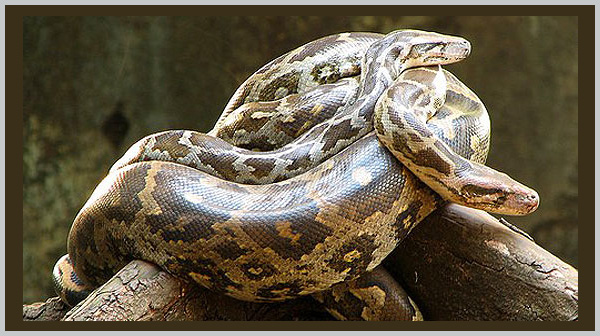
Indian Python
Throughout history, humans have regarded snakes with both fascination and horror. In many cultures, snakes have been symbols of evil, from the Biblical serpent in the Garden of Eden to the snake demons of Indian mythology. To the ancient Egyptians the emblem of judgment and death was a snake. This perception of snakes has not fared well for the Indian Python.
Snakes are found in most habitats worldwide except in extreme northern and southern regions. Snakes come in multitudes of sizes and colors with as many varied lifestyles, from deadly King cobras whose bite can kill a human in 15 minutes, to the world’s tiniest West Indies thread snakes, about the size of a pencil lead.
Snakes are reptiles, the group of animals that also includes crocodiles, lizards, and turtles. The now-legless snakes evolved millions of years ago from prehistoric lizards that lived at the same time as the dinosaurs. Pythons are the most ancient type of snake; they have remnant spurs, tiny projections where their ancestors might once have had legs.
Species Description and Natural History
The Indian python is a highly arboreal snake, once fairly common throughout the jungles of India, Sri Lanka, and the East Indies. It can grow to a length of about 20 feet (6 m).
Like the boas and anacondas of the Americas, the python is a constrictor, a snake that kills its prey by squeezing. Mammals are preferred prey, but pythons will also eat birds, other animals, even fish (pythons often live near water and are good swimmers).
Pythons drape across tree branches, camouflaged by their light and dark patterned skin, waiting to ambush their next meal. They grab their prey with a quick lashing out of the head, then wrap themselves around the prey so it cannot breathe. A large python could squeeze the life out of a deer, and amazingly enough, the python could then swallow it whole.
After such a big meal, the snake may not have to eat again for as long as a year! There are very few authenticated accounts of humans being attacked by pythons, though it certainly is possible since the largest python recorded was over 32 feet (9.8 m) long.
A python may live more than 20 years. They are solitary creatures, but males and females seek each other out to mate. The female coils about her eggs to incubate them. Young pythons have many natural enemies, including eagles, crocodiles, large cats such as leopards and tigers, and hyenas.
Snakes are important in controlling pest species, such as rodents, rabbits, and insects. In some areas where humans have eradicated snakes, mice and rodents that carry disease have become serious threats to human health.
Causes of Endangerment
Overexploitation
For centuries, humans have killed pythons out of fear. Snakes of all kinds are also hunted for food, skins, and blood believed to have medicinal values. Live snakes are killed to order in Thai markets so customers can drink the fresh blood, thought to impart vitality. Python and other snake skins are made into fashionable accessories such as purses, shoes, and belts.
Snakes often are skinned alive so as not to mar the skin and reduce their commercial value. Even before snakeskin boots were fashionable, pythons were considered a trophy species and hunted heavily by Europeans. More recently, they have become sought after for the pet trade and for zoos.
Habitat Loss
In addition, the python’s jungle habitat is disappearing as trees are cut down for lumber, firewood and to make room for spreading human settlement and agriculture (see Spotlight on tropical rain forests).
Conservation Actions
Trade Regulation
Pythons are listed in CITES Appendix I. All trade in live pythons or python products is prohibited. Poaching remains a threat, however, and illegal trade continues.
Habitat Protection
Although India has established several large areas to protect habitat, these reserves are unpopular with the people who live near them and want access to the forests to obtain firewood or food. The problem of rampant poaching has been addressed in some places by armed-guard patrols.
A better long-term solution would reconcile the reserves with the needs of local people, including controlled access with better education about how conservation can benefit people as well as wildlife.
Captive Breeding
Captive breeding programs are being promoted to supply snakes for the pet and zoo trade, reducing poaching pressure. Zoos no longer accept wild-caught pythons.
Question for Thought
What do you think of the practice of skinning snakes alive in order to preserve the quality of the skin?
Humans have long persecuted large predators, such as the Indian python. What other endangered species have been hunted and feared because of their place at the top of the food chain? What happens to ecosystems when predators are eliminated?
Related Classroom Activities
[CS1-1, CS1-9,CS2-2, General]